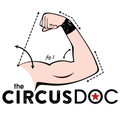Most circus performers I know love to warm up their rotator cuffs before training or for strengthening after training. However, when I look around and watch what these fabulous artists are doing, it’s clear most of them are just doing it wrong. So, what are they actually doing and how can they (and you!) do it better?
How to do proper shoulder external rotation with a resistance band.
- Start standing with the band anchored away from the side of the body that you are trying to train. The band should be at about elbow height and you can hold the band with the hand of the moving arm.
- Gently engage your parascapular musculature to secure your shoulder blade in good standing alignment. (I like to think of my shoulder on a clock face and gently rolling my shoulder back to the 10 o’clock position) Allow your arm to be in line with the shoulder joint with the elbow bent to 90 degrees
- Spin the arm in the socket. The elbow should remain in place and it should be a smooth spinning motion without pushing into the end range
- Slowly return to the starting position
Here are the things that commonly go wrong, what to look for, and why they aren’t helping
- Shoulder blade is pulled down (as in the video below) This position demonstrates that the latissimus dorsi (lats) are stabilizing the scapula instead of your middle traps. This is a problem for (at least) two reasons. The lats are an internal rotator and that places undue stress on the joint as you are trying to externally rotate. The other and most important problem is that you are training a pattern of stabilization that will not support your shoulder properly, especially in overhead positions.
- To tell if you are doing this look in a mirror or feel the muscles at the torso side of the armpit (lats) they should be relaxed during this exercise
- Arm is too close to your side (as in the video below) We want to train the rotator cuff to stabilize the head of the humerus into the shoulder socket. By pulling the arm in next to the body, you are levering the head of the humerus outward. Also, this position provides false stabilization by engaging the lats as an adductor. This causes the same problems as in the example above. To fix this problem some people add a towel roll, but be careful not to squeeze it!
- To check, look in a mirror or feel for the musculature as above
- The arm is not spinning in the socket. This is common in the hypermobile circus population and it can turn this helpful exercise into a possible injury source. If the humerus isn’t spinning properly in the socket, it is causing undo stresses on the ligaments and tendons that hold the shoulder in place, and you aren’t getting the strengthening benefit of the exercise.
- Look for the elbow moving around (usually backwards) or feel the front of the moving shoulder. You should feel the humerus spin under your hand but not push forward. This can also occur if you ‘push’ into the end range. Don’t force the motion. Allow the rotator cuff to spin the arm.
Now, watch the video below. Review the proper performance and have fun training!
